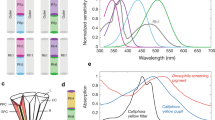Abstract
Hotta and Benzer (ref. 1), using loss of phototactic response as an indicator of defective vision in ebony11 and tan1 mutants of D. melanogaster, have shown that these mutants also possess abnormal electroretinograms (ERGs). Certain other body colour mutants, however, such as black, show normal ERGs, suggesting that body colour abnormality and defective ERG are unrelated. Pearce (now Crossley)2,3 reported that the ebony gene influenced behaviour in a number of ways, not all of which could be related to defective vision. A more detailed analysis of the mutants studied by Hotta and Benzer is therefore of interest.
This is a preview of subscription content, access via your institution
Access options
Subscribe to this journal
Receive 51 print issues and online access
$199.00 per year
only $3.90 per issue
Buy this article
- Purchase on Springer Link
- Instant access to full article PDF
Prices may be subject to local taxes which are calculated during checkout
Similar content being viewed by others
References
Hotta, Y., and Benzer, S., Nature, 222, 351 (1969).
Pearce, S., Anim. Behav., 8, 232 (1960).
Crossley, S., thesis, Oxford Univ. (1963).
Rendel, J. M., Evolution, 5, 226 (1951).
Jacobs, M. E., Ecology, 41, 182 (1960).
Author information
Authors and Affiliations
Rights and permissions
About this article
Cite this article
CROSSLEY, S., ZUILL, E. Courtship Behaviour of some Drosophila melanogaster Mutants. Nature 225, 1064–1065 (1970). https://doi.org/10.1038/2251064a0
Received:
Revised:
Issue Date:
DOI: https://doi.org/10.1038/2251064a0
Comments
By submitting a comment you agree to abide by our Terms and Community Guidelines. If you find something abusive or that does not comply with our terms or guidelines please flag it as inappropriate.



